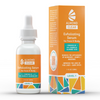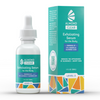Fungal Acne Before and After
Fungal acne is inflammation and infection of the hair follicles that is caused by Malassezia yeast. It can look very similar to acne, except that the bumps are smaller and more uniform in size. Malassezia yeast is actually always present on the skin. Usually your body is able to balance the yeast, fungi, and other bacteria that are part of your skin’s microbiome, but if the balance of your skin gets out of whack, an overgrowth of yeast can occur, which infects the hair follicles, leading to fungal acne. Yes, fungal acne can be extremely frustrating to deal with because it doesn’t respond to typical acne treatments, but it IS totally possible to clear it up.

Fungal acne before and after Almond Clear - Fungal acne on cheeks and scalp
Skincare Products for Fungal Acne
Exfoliation is key when treating folliculitis. Unclogging the follicles will help prevent bacteria and fungus from growing in them. It’s also crucial to use products that are both antifungal and antibacterial. Here are some to look for when clearing up fungal folliculitis.
- Mandelic Acid serums and cleansers (antibacterial, antifungal, and exfoliating)
- Ketoconazole cleansers or shampoo (antifungal)
- Sulfur-containing soaps and creams (antifungal, mildly exfoliating)

Skincare Products to Avoid for Fungal Acne
The Malassezia yeast that causes fungal acne is fed by most types of oil as well as a many other common skincare ingredients, which is why it's essential to educate yourself on which products will inflame your skin concern. Here are some of the most common skincare ingredients that are NOT fungal acne-safe.
- Fatty acids and oils: Malessezia yeast feeds on most oils and fatty acids, so if you apply skincare products that contain these ingredients, your fungal acne will worsen and spread. Some examples are: Laurice acid, Myristic acid, Tridecylic acid, Palmitic acid, Stearic acid, Oleic acid, and Linoleic acid.
- Esters: Esters are actually a combination of a fatty acid and an alcohol or glycerol. Esters in skincare products usually end with ‘ate’, so look out for that on ingredient lists and you should be good to go. Some examples are: isopropyl palmitate, decyl oleate, and glyceryl stearate.
- Polysorbates: This is another sneaky ingredient that feeds fungal acne to grow. To avoid polysorbates, look on the label for any ingredient with 'polysorbate' as part of its name. Some examples are: Polysorbate-20, Polysorbate-40, Polysorbate-60, Polysorbate-80.
- Fatty Alcohols: Most fatty alcohols come from vegetable sources, such as coconut or palm oil, which clog pores and hair follicles, leading to more fungal acne. Some examples are: lauryl, stearyl, and oleyl alcohols.
- Yeast Ferments: Fermented skin care means that microorganisms (bacteria) have been added. Adding extra bacteria and/or yeast to the skin should definitely be avoided if you have fungal acne. Some examples are: berries, seaweed, tea and yeast.
- Coconut Oil: Coconut oil should be avoided for both fungal acne and regular acne sufferers because it’s highly comedogenic, meaning that it clogs pores. Besides that, it’s made up of 47% lauric acid, which is one of the main fatty acids that feed Malessezia yeast.
For a comprehensive list of the ingredients to avoid, and all of the science behind why, check out Simple Skincare Science's blog post 1500+ Fungal Acne Safe Products. You can check if your favorite skincare products are fungal acne- safe at Foliculitis Scout.

Fungal Acne Skincare Routine
Trust us, you don't need a 10-step skincare routine to treat your fungal acne. On a daily basis, you should always keep it simple with these four steps: (1) cleanse, (2) treat, (3) moisturize and (4) SPF. Before bed, repeat the first three steps again.
Step 1: Cleansing
Daily cleansing is a crucial part of your skincare routine because it removes dirt, sweat, oil, and makeup from the surface of your skin, all of which feed fungal acne breakouts. Here are some of our favorite fungal acne-safe cleansers:
- Almond Clear’s Face and Body Wash: This gel formula is powered by Mandelic Acid which is strongly antibacterial and antifungal, so it clears up the microbes that cause folliculitis.
- Vanicream Gentle Facial Cleanser: This gentle cleanser is oil-free, non-comedogenic, and completely fungal acne-safe. It helps remove dirt, oil and makeup without drying the skin. This is a great choice for very sensitive or dry skin.

Fungal acne before and after Almond Clear- Fungal acne on chest
Step 2: Leave-on Treatment
Applying a leave-on product every day is THE most critical step in your routine. This is because a product that stays on the skin has time to fight off the microbes that cause folliculitis while also exfoliating to unclog blocked hair follicles and pores. Apply your leave-on treatment to clean, dry skin and let dry for 60 to 90 seconds before moving on to the next step. Here are our favorite fungal acne-fighting leave-on treatments:
- Almond Clear Face & Body Clearing Serum: This serum contains 10% Mandelic Acid and is excellent at clearing up mild to severe folliculitis and acne. It’s antibacterial, antifungal, and exfoliating, so it fights off the microbes that cause fungal acne from forming, while also shedding dead skin cells to unclog pores.
- Malezia Acne Treatment Gel: This 2.5% benzoyl peroxide gel treats acne and folliculitis, eliminates blackheads, and smooths skin texture.
- The Ordinary Niacinamide 10% + Zinc 1%: This leave on acne treatment visibly regulates sebum, minimizes pores and is completely fungal acne safe.
Step 3: Moisturizer
The leave on treatments in Step 2 will dry out your skin, so it’s important to apply a good moisturizer. This will hydrate your skin, help regulate oil production, and keep your skin barrier intact.
We are so excited to announce that Almond Clear will be releasing a cream-based moisturizer that's folliculitis-safe in the fall of 2023.
If you haven’t found the right moisturizer yet, one of these fungal acne-safe options will definitely be your next go-to.
- Almond Clear's Soothing Daily Moisturizer : This moisturizer hydrates and nourishes the skin without leaving a sticky residue. It quickly absorbs and is safe for acne and folliculitis-prone skin.
- Malezia 5% Urea Moisturizer: This moisturizer’s main ingredient is urea, a molecule found in the skin's natural moisturizing factor (NMF) that plays an integral role in improving skin barrier function. Urea has the ability to both hydrate and gently exfoliate the skin.
Make sure to check out Simple Skincare Science for more folliculitis-safe options.
Step 4: Sunscreen
Yep - you’ve heard it time and time again, but it’s extremely necessary to wear sunscreen every single day, especially if you apply a leave-on acne treatment such as alpha hydroxy acids or benzoyl peroxide which make your skin more sensitive to the sun. Plus, if you have dark marks from previous blemishes, sun exposure will only make them darker and more apparent.
- Cotz the healthier Sunscreen: This is a mineral sunscreen that keeps your skin safe from harmful UVA-UVB rays. Great for fungal acne!
- EltaMD UV Clear Facial Sunscreen: This sunscreen is oil-free and recommended by dermatologists, as it helps calm and protect sensitive skin types prone to acne, rosacea and discoloration.
- La Roche-Posay Anthelios Mineral: A sensitive skin sunscreen with broad spectrum UVA/UVB protection SPF 50. Fast absorbing, non-whitening, non-greasy Zinc Oxide sunscreen. Suitable for use under makeup. Oxybenzone-free.

Lifestyle Changes to Avoid Fungal Acne
Besides sticking to an effective, fungal acne-safe skincare routine, it’s crucial that you remove any environmental factors that could be contributing to your fungal acne. Here are some of the most common environmental triggers:
- Rinse immediately after working out/sweating: Folliculitis thrives in warm, moist conditions, and the combination of sweat and oil contain all of the nutrients needed for the reproduction of folliculitis-causing microbes. Make sure to shower right after sweating. If you can’t shower after exercising, then it’s helpful to apply a little Almond Clear to your folliculitis-prone areas. This will keep the microbes from spreading until you can shower up.
- Take an oral antifungal supplement: If you have a fungal skin infection, it’s possible that your GI tract also has a microbial imbalance. You can clear that up with antifungal supplements. Good choices include caprylic acid, undecylenic acid, oil of oregano, garlic, olive leaf, and berberine. Allways consult your doctor before taking a new supplement.
- Trapped Moisture & Tight Clothes: Most people who deal with fungal acne tend to sweat a lot, either naturally or through exercise. Wearing sweaty workout clothes, re-wearing workout clothes, or just naturally sweating in tight, non-breathable clothing can encourage yeast to grow, causing fungal acne. Try wearing looser-fitting clothes when possible, and choose natural, breathable fibers like cotton. If you live in a humid, sweat-inducing environment then try to bathe and change your clothes more frequently.
- Avoid prolonged exposure to hot or warm water: Minimize your time in hot tubs, baths, and steam rooms. You don’t have to eliminate steamy water from your life, just avoid it when you can.
Although tricky to understand and treat, fungal acne can be kept at bay with the appropriate skincare routine and lifestyle changes.








